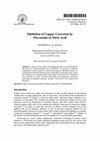Determination of Capsaicin and Dihydrocapsaicin in Some Chilli Varieties using Accelerated Solvent Extraction Associated with Solid-Phase Extraction Methods and RP-HPLC-Fluorescence
引用次数: 29
Abstract
Reversed phase-HPLC with fluorescence detection of two major capsaicinoids was described. Isocratic elution using a ratio of methanol and de- ionized water (66:34, v/v) as mobile phase was used at a flow rate of 0.9 mL/min with well achieved separation within 6 min. Under optimum conditions, their analytical figures of merit for the HPLC method were validated. The linearity was in the range of 1.0-25.0 g/mL with multiple determination coefficients of higher than 0.995. The limit of detection was ranged of 0.008-0.01 g/mL. The repeatability and reproducibility of the retention time and peak area for these compounds were in good precision with their relative standard deviations (RSDs) lower than 1% and 5%, respectively. Both capsaicin and dihydrocapsaicin were extracted using an accelerated solvent extraction (ASE) of methanol as an extraction solvent for 5 min static time with 3 cycles. The methanolic extracts were subjected to clean up with C18 solid-phase extraction (SPE) with its recoveries ranking of 90.2-98.0%. The method recoveries of real samples were found to be 60.7-98.6%. The optimized extraction method were applied for the determination of the two capsaicinoids in ten vareities of hot chilli pepper samples. Total contents of capsaicinoids were found in the range of 2,307.0-9047.3 g/g DW with their corresponding Scoville heat unit (SHU) of 34,600-135,700. Additionally, the contents of capsaicinoids using external calibration method comparing with those of standard addition were not significantly different, indicating accuracy of the method. Mostly, the contents of capsaicin found in these real samples were rather higher than those of dihydrocapsaicin.加速溶剂萃取-固相萃取-反相高效液相色谱-荧光法测定部分辣椒品种中的辣椒素和二氢辣椒素
采用反相高效液相色谱法荧光检测两种主要辣椒素。以甲醇与去离子水的比例(66:34,v/v)为流动相,流速为0.9 mL/min,在6 min内分离效果良好。在最佳条件下,验证了其高效液相色谱法的分析参数。在1.0 ~ 25.0g/mL范围内线性良好,多重测定系数均大于0.995。检出限为0.008 ~ 0.01g/mL。样品的保留时间和峰面积的重复性和重现性均良好,相对标准偏差(rsd)分别小于1%和5%。采用加速溶剂萃取法(ASE)提取辣椒素和二氢辣椒素,萃取溶剂为甲醇,静态时间为5 min,循环3次。甲醇提取物经C18固相萃取(SPE)净化,回收率为90.2 ~ 98.0%。实际样品的回收率为60.7 ~ 98.6%。将优化后的提取方法应用于10个品种辣椒样品中两种辣椒素的含量测定。辣椒素总含量在2,307.0 ~ 9047.3g/g DW之间,对应的史高维尔热单位(SHU)为34,600 ~ 135,700。此外,采用外标法测定的辣椒素含量与标准添加法测定的辣椒素含量差异不显著,说明了该方法的准确性。在这些实际样品中发现的辣椒素含量大多高于二氢辣椒素。
本文章由计算机程序翻译,如有差异,请以英文原文为准。
求助全文
约1分钟内获得全文
求助全文

 求助内容:
求助内容: 应助结果提醒方式:
应助结果提醒方式:


